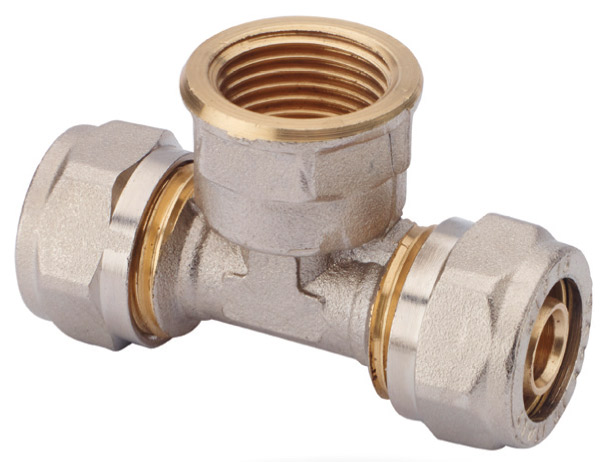Nickel-plated brass: an excellent choice for multilayer pipe fittings

The starting point: brass
Brass is an alloy consisting mainly of Copper (Cu) and Zinc (Zn) which is characterized by high qualities of ductility and malleability, as well as good resistance to corrosion. The machinability of the machine tools is good, but the toughness of the material tends to constitute very long chips: for this reason many times small percentages of lead are added which disperses on the grain edge and causes the reduction of the size of the chip produced, reducing, between the many problems, the overheating of the tools used. Other main elements that can generally be added are:- Manganese and Silicon: increase resistance to corrosion;
- Iron: increases mechanical resistance;
- Aluminum: increases resistance to corrosion and abrasive wear.
Brass, which has different structures depending on the percentage of zinc, can be used in many applications: in particular, it is used for the realization of various types of fittings and also for the multilayer pipe fittings.
What is nickel plating for?
Nickel plating is a surface treatment that improves the corrosion resistance and durability of the component over time, even in difficult and particularly aggressive environments. There are two main variants of this type of technique:- Electrolytic nickel plating: can only be carried out on metals and occurs by immersing the component in baths where an electric current passage is created which leads to the surface deposition of a layer of nickel.
- Chemical nickel plating: unlike the previous one, it can be used on many types of materials (metals, glass, polymers, etc). Generally it has a more precise coating that perfectly follows the profile of the product being treated. For this reason it is widely used when machining precision or structural parts: respect for geometry allows to reach a high degree of properties and improve the working life of the component.
A pretreatment suitable for the deposition of the nickel layer is micro shot peening. This operation is essential to homogenise the surfaces and create a minimum state of surface roughness which proves particularly suitable for the adhesion of the deposited surface layer. The hardness of the deposited layer is around 560-600 HV but, with a suitable heat treatment, the system can also reach hardnesses of the order of 1000 HV.
The use of nickel plating in multilayer pipe fittings
The realization of the multilayer pipe fittings in nickel-plated brass brings advantages both from the aesthetic point of view (it has a greater resistance to darkening with the passage of time) and as regards the hardness and resistance to corrosion by very aggressive environments, which can be , for example, the construction sites where the multilayer pipes with their respective fittings are put into operation.About chemical nickel plating
Nickel plating, as seen previously, is a surface treatment that improves the durability and corrosion resistance of fittings for multilayer pipes and many other components. This process can be carried out by applying current and immersion in a bath, we are talking about electrolytic nickel plating, or without the application of a current, in this case we are talking about chemical nickel plating.For chemical nickel plating, the reaction is generated by the presence in the treatment solution of a chemical reducing agent which leads to the establishment of a controlled autocatalytic reaction. This type of nickel plating allows you to cover a wide range of materials and not just metals, as long as they are suitably pre-treated through suitable processes such as shot peening.
The thicknesses that are generally found with this type of nickel plating are of the order of 5-10 μm for applications in not too aggressive environments but, if they are in contact with environments whose aggressiveness rate is high, such as in salt water for example , the thickness can reach up to 100 μm.
The considerable advantages of this type of technique are:
- Possibility of covering a greater number of materials;
- Distribution of nickel over a much more uniform thickness than with the electrolytic technique;
- Possibility of covering much more complex geometric shapes as it does not require the use of auxiliary anodes;
- It can be used both to lay a final layer and to lay an intermediate layer that serves as a basis for further operations and depositions.
How to choose Nickel?
The nickel chosen for the nickel plating operation can be of different types depending on the chemical composition chosen: in fact, the main element that plays a role on the characteristics and properties of nickel is phosphorus (P).1. Low phosphorus (1-3%): it is a choice that is usually made when the mechanical characteristics are mainly of interest with respect to corrosion resistance. In fact, this phosphorus content guarantees high hardness and wear resistance, as well as acting in an important way on the development of cracks by establishing compression stresses in the piece;
2. Medium phosphorus (4-9%): generally used as a substrate for subsequent coatings, it guarantees good mechanical properties and resistance to corrosion. For this reason, it is the type of nickel plating that is usually preferred for applications in the automotive, aeronautical, military, etc.;
3. High phosphorus (10-13%): mainly used for corrosion resistance which is the main property. It gives good ductility and discrete mechanical properties that limit the occurrence of cracks and related fractures. It is a type of material that is also often used in the food sector, as it has characteristics suitable for contact and storage of foods or other related products.
11/01/2021
I contenuti di questo sito non hanno carattere di periodicità e non rappresentano 'prodotto editoriale'.








